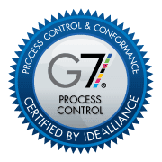A Great Way to Avoid Printing Disappointments
 Commercial Printing, like most other industries, has changed. After all, printing is no longer a craft-based business. It’s become a manufacturing process, like most others. As such, it’s crucial for print providers to be able to not only deliver a repeatable color product, but to do so as efficiently as possible if they’re to ensure complete customer satisfaction with the finished printed product. However, not all printers are equal. To help you sort things out, I’ve put together some information that I believe will be of great interest and value to you.
Commercial Printing, like most other industries, has changed. After all, printing is no longer a craft-based business. It’s become a manufacturing process, like most others. As such, it’s crucial for print providers to be able to not only deliver a repeatable color product, but to do so as efficiently as possible if they’re to ensure complete customer satisfaction with the finished printed product. However, not all printers are equal. To help you sort things out, I’ve put together some information that I believe will be of great interest and value to you.
Audrey Ferrante
Ferrante & Associates, Inc.
WHY G7 MATTERS WHEN SHOPPING FOR PRINTING SERVICES
What you see is not always what you get, which is why G7 really matters. I’m sure, if you’re a buyer of print, you’ve seen the G7 logo. However, many people really don’t understand what it means for them.
 G7 Process Control (PC) is designed to help print providers (commercial printers) achieve a high level of efficiency and predictability through standardization and process control practices, which, in turn, allow them to offer their clients (you) repeatable consistent quality color printing in the most efficient manner possible.
G7 Process Control (PC) is designed to help print providers (commercial printers) achieve a high level of efficiency and predictability through standardization and process control practices, which, in turn, allow them to offer their clients (you) repeatable consistent quality color printing in the most efficient manner possible.G7 Method and G7 PC.
G7 PC is an extension of G7 Method, IDE Alliance’s proof-to-print process, which is based on principles of digital imaging, spectrophotometry, and computer-to-plate (CtP) technologies. G7 is a set of streamlined procedures created by GRACoL,* which are packaged, promoted and administered as a certification standard by IDE Alliance. By utilizing the existing ISO 12647 Standards, G7 forms the basis for good printing.
With G7, printers are able to go through a series of technical steps in a clear logical path of discovery to determine the inherent print capabilities of their equipment. They use all the information they gain to tune and adjust for the purpose of creating best-practice levels and customized ICC profiles for each print output device, and each printing press and paper type. The customized profiles are applied to files either before or at the Raster Image Processor (RIP) prior to output on a CTP (Computer-to-Plate) device or digital press, ensuring the very best quality and consistency in 4-color printing.
What’s more, all inks— litho, jet, and electro, as well as dry toners must also be within tolerances specified in the G7 process set-up. This is why each device requires individual ICC profiles to adjust to gray balance within the limitations of the pigments or toners. Each profile is uniquely created with the intention of visually matching as close as possible to the G7 gray balance target. In addition, the variable paper surface (coated or uncoated), and paper white point readings must also be considered and factored into the profile within the printing limitations of each device.
It doesn’t end there, because when prepress operators process files for production they need to select the correct ICC profile for the press, output device and paper type to create the correct result. Proofing systems are limited because they generally use only one certified type of proofing paper, which is why the ICC profiles delivered to the proofing system need to emulate attainable results for each intended printing device. As proofing systems are mainly inkjet based with a very wide gamut of colors, they need to emulate just about any variation the actual production device is capable of producing.
Dot gain, spot emulations, and line screen AM /FM all contribute to the complexity of attaining correct color as well. What that means is if a file is intended for a specific litho press, and the specifications call for 175 line conventional dots on coated stock, the G7 process makes a profile available for that for prepress to select. Likewise, if the same job is to be processed using FM screen, a different profile is used to obtain the same color results on press. If a different press in the same shop is selected, then yet another ICC profile is used to obtain the same color result when printed.
Even with G7, the success with this process is related to the diligence required of management and prepress operators to assign the correct profile for the intended output or print device. This is where an effective Management Information System (MIS) is vital. If a plant has a good MIS system that delivers JDF instructions to prepress systems, then the entire device profile selection process can be automated, and done on the fly. At the end of the day, the goal is to specify a simple calibration process that will help printers reliably achieve a close “visual match” from proof-to-press, and press-to-press. G7 does this by breaking from tradition, and focusing on colorimetric data for gray balance in the mid-tones rather than on densitometry aims, i.e. dot gain for each color.
In case you were wondering, G7 is named for its gray-scale calibration technique and the seven (7) ISO ink colors it requires. It also includes a detailed certification process, equipment calibration and employee training. Once a printing plant has completed the certification process, G7 standards can be implemented on multiple presses and different print technologies to produce a common appearance.
Why a printer needs G7 PC.
As the world grows smaller, and printing technology becomes more diverse, having standardization and process control practices in place is crucial for print providers to offer their clients the consistency of color across the plant, and across the globe. When you do business with a G7 certified company, you can rest easy knowing that when your print project is transferred from color proof to final product, you’re getting what you approved, and what you paid for. With G7 PC, you never have to lose sleep over whether or not the color you saw at the proofing stage will match up with the color you see when your printing project is printed, trimmed, dried and delivered.
What does G7 mean to you, the print buyer?
- Less stock required, faster time to press plus on press means reduced costs.
- Assurance that your proof represents your file, and the press sheets will match your proof.
- Reduction and eventual elimination of costly on site press checks.
- Assurance that proofs you approve can be duplicated and maintained on press.
- If your application requires production in several areas of the country or the world, G7 certified sites are more likely to match your approved proof even on differing equipment because they use the same G7 set-up process and operational procedure.
- If your print applications require both litho and digital press equipment, you are more likely to get consistent color results between differing print equipment with G7 certified print sites..
- G7 benefits become critical when you produce national brands that require multiple production sites, and/or combinations of devices like heatset web, sheet-fed litho, digital or flexo.
Does G7 work at all print shops that are certified?
Simple answer, “a good process is only as good as how it’s practiced.”
In order to remain certified, G7 print sites must first follow an implementation procedure, and then maintain consistent process controls with periodic audits.
After reading the above information you can see that delivering consistent color, making deadlines, and getting the right price doesn’t happen by chance.There are many good printers providing finished products that are not G7 certified. However the advantage of working with G7 certified printers is that they are equipped with global standards that maintain color consistency and offer a common appearance on different materials and different technologies.
 If you liked this article please share it with anyone that can benefit.
If you liked this article please share it with anyone that can benefit.
Thanks for reading this month’s Ferrante Speaks Newsletter and learning about the important role graphic design plays in multi-channel marketing. If you’d like to learn more about the thinking around here at Ferrante & Associates, subscribe to our blogs. You may also follow us on Twitter, Google+ and Facebook.
Special thanks to Gary Preuss for all his help in developing this newsletter.
*Although G7 was developed by the efforts of the GRACoL Committee, it should not be confused with GRACoL or with GRACoL 7.







